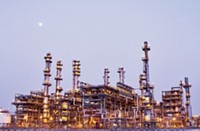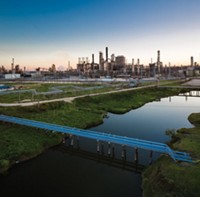Advertisement
Grab your lab coat. Let's get started
Welcome!
Welcome!
Create an account below to get 6 C&EN articles per month, receive newsletters and more - all free.
It seems this is your first time logging in online. Please enter the following information to continue.
As an ACS member you automatically get access to this site. All we need is few more details to create your reading experience.
Not you? Sign in with a different account.
Not you? Sign in with a different account.
ERROR 1
ERROR 1
ERROR 2
ERROR 2
ERROR 2
ERROR 2
ERROR 2
Password and Confirm password must match.
If you have an ACS member number, please enter it here so we can link this account to your membership. (optional)
ERROR 2
ACS values your privacy. By submitting your information, you are gaining access to C&EN and subscribing to our weekly newsletter. We use the information you provide to make your reading experience better, and we will never sell your data to third party members.
Business
Gearing up for More
Middle Eastern producers seek their place on world supply, marketing, and R&D stages
by PATRICIA L. SHORT, C&EN LONDON
March 21, 2005
| A version of this story appeared in
Volume 83, Issue 12

In the next 10 years, capacity for ethylene in the Middle East is set to more than double, to nearly 30 million metric tons per year. Capacity for propylene will nearly triple in that time, to almost 7 million metric tons per year.
Those are big numbers--but then, global demand for ethylene and propylene are big numbers, too, and capacity is expanding in other regions as well. What is striking about the Middle Eastern projects is the percentage of world supply that they will be making up.
Andrea V. Borruso, senior consultant with the world petrochemicals program in SRI Consulting's Zurich office, says early indications are that, over the next 10 years, roughly 30 million metric tons of ethylene capacity will be added to current production. Of that additional capacity, 40% will be in the Middle East.
As Graham Harris, director for Europe and Middle East polyolefins studies in the London offices of consultants Chemical Market Associates Inc. (CMAI), puts it: "By 2012, the Middle East will be the great provider of petrochemicals. China will be the great sink. North America will become a net importer, as will Europe."
With their increasing muscle in the marketplace, Middle Eastern companies are also paying more attention to the rest of the world. International companies have been active in joint ventures and partnerships for years in the region. Examples include Union Carbide, now Dow Chemical, with Petrochemical Industries Co. (PIC) of Kuwait; Borealis with the Abu Dhabi government; and a host of companies in ventures with Saudi Basic Industries Corp. (SABIC).
Now, however, Middle Eastern companies are looking outward. The first major step was SABIC's acquisition in 2002 of the petrochemicals operations of DSM, which gave the Saudi Arabian company a strong market position in Europe.
Iran, the other powerhouse of the region, is also looking outward, and its National Petrochemical Co. (NPC) is one of the three companies short-listed by BASF and Shell to buy their Basell polyolefins joint venture. The other two are privately held Ineos of the U.K., and a financial consortium that includes Indian petrochemical producer Haldia Petrochemicals.
The sale--to whomever--is expected to be worked out by the end of the second quarter, according to BASF. It would be easy enough, consultants say, for NPC to structure a deal with a third party to "baby-sit" Basell's U.S. operations, thereby avoiding U.S. government sanctions.
It all comes down to the increasing awareness of the region's countries that it makes economic sense to exploit their immense reserves of natural gas. Ethylene and propylene have come first; downstream derivatives are on the project slates as well. Harris, however, does not see the region's production becoming too fancy. "If you've got the cost advantage, it makes sense to make the vanilla."
New investments in the region include projects in various stages of planning and preparation in Abu Dhabi, Oman, Kuwait, Qatar, and Saudi Arabia.
There is also Iran. "At this point, the infrastructure is in place," Borruso says, for four major projects, in addition to what already exists. Six other projects are under consideration.
Borruso acknowledges that NPC's project announcements have lacked some credibility in the past. He theorizes that, perhaps for political reasons, NPC has been exaggerating overly optimistic start-up dates. "But even discounting those overstatements," he says, there are real Iranian projects at Bandar Imam, on the Persian Gulf opposite Kuwait; and at Assaluyeh, opposite Bahrain.
In fact, adds CMAI's Harris, the limiting constraint in Iran is the availability of construction cranes. And there is little likelihood that the construction will cool down.
M. R. Nematzadeh, Iran's deputy petroleum minister and NPC's president, says his company has drawn up a 10-year prospective program for 2005–15 to continue the country's growth in petrochemicals output. Underpinning those plans, the company will invest $17.5 billion under its fourth five-year development plan, for 2005–10. By comparison, NPC spent a combined total of $12.5 billion in its first three five-year plans, says Seyyed Hassan Sadat, NPC's director of projects.
Some of the technology is the company's own. Other technology, however, is coming in from international partners. Basell, for example, has sold the Iranians a lot of technology, although it has not taken partnership in projects, Borruso points out. Sasol is active with the polyethylene joint venture Arya Sasol, Japanese and Korean firms are investing in the country, and Chinese and Indian investors are interested.
"Everybody is selling technology, but there is no business for U.S. companies. The Iranians are proceeding--the strength of their energy is such that they will proceed anyway" without U.S. investment, Borruso says.
On the other hand, U.S. companies, as well as other Western investors, are widely evident in other countries in the region. For example, last month, Dow Chemical and Kuwait's PIC broke ground on their Olefins II project.
Another example is Chevron Phillips Chemical, which has a chemicals deal with Saudi Aramco at Al-Jubail, Saudi Arabia. Aramco, which is also planning an ethylene complex with Sumitomo Chemical, has made the Arabian industry much more complex recently, according to some consultants, by its recent decision to go downstream from petroleum into petrochemicals--thus entering into direct competition with SABIC, one of its primary feedstock customers.
SABIC--which was ranked number 34 in the first C&EN Global Top 50 ranking in 1990 but has grown to reach number 12 last year--is not resting on its laurels. For example, last month, it awarded a service contract to Foster Wheeler to manage the third expansion of its Sharq site.
To support that growth, SABIC in 1994 established a research and technology center in Riyadh, Saudi Arabia; it subsequently added centers in Houston, in 1997, and in India, in 2002.
The Riyadh center, which employs some 550 people, has the long-term goal of developing a new technological base, enabling SABIC to diversify within its core business sectors. Among its accomplishments are a new catalyst to produce 1-butene and a new acetic acid technology based on conversion from ethane.
But other countries in the region are also working to build up their science capabilities to augment abundant natural resources.
A CASE in point is Qatar, which boasts that it sits on the world's largest single gas field and aims to be a world leader in the export of liquefied natural gas. Last year, it established in Doha a Science & Technology Park (STP), part of the Qatar Foundation's Education City campus of schools, universities, and research centers. U.S. universities with degree programs in Education City include Texas A&M, Carnegie Mellon, and Weill Medical College of Cornell.
The first phase of STP's multiuser buildings, currently under construction, will open by the end of the year. Last month, Shell's chief executive, Jeroen van der Veer, committed his company to spend up to $100 million over a 10-year period at STP. "We expect this facility to become one of our company's centers of excellence in the world," he said at the time.
And in 2002, Iran's NPC transformed its R&D center into a separate company, National Petrochemical Co. The subsidiary has several areas of focus: improving existing products and processes, acquiring new technologies, developing catalysts, and conducting customer-oriented research for applications and product development.
Among the R&D projects in the region are undoubtedly ones devoted to resolving one sizable problem: a relative shortage of propylene.
The region relies on its ethane feedstock, and its cost advantage is considerable. CMAI's Harris estimates that the cash cost of making a metric ton of high-density polyethylene in the U.S. is $710, compared with $280 in Saudi Arabia. Even adding in import duties and ocean freight costs, Saudi producers can deliver HDPE to U.S. ports at $475 per metric ton, he says.
Moreover, Harris adds, there is little likelihood of the ethane running out. On the other hand, demand for propylene is swamping the available supply.
"Propylene started out as a by-product, then became a coproduct, and now stands alone," he observes. "The growth of propylene and polypropylene is stronger than that of ethylene and polyethylene, as polypropylene has graduated to being a polymer of choice."
But there is little propylene that can be wrested from the Middle East's natural gas-fed crackers, and capacity expansions will bring little of the C3 product along with them. Hence the decision by companies in the region to investigate other routes to propylene, including propane dehydrogenation, which now accounts for 2% of world propylene production; metathesis, which accounts for 1%; and the "tweaking" of fluid catalytic cracking in oil refineries, which accounts for 30%. Steam cracking of naphtha is the world's largest source of propylene, at 67%.
Last year, Basell committed to building a polypropylene plant and upstream propane dehydrogenation unit in Saudi Arabia with Sahara Petrochemical, due onstream in 2007. Other Middle Eastern propylene projects are already under construction.
Metathesis--the disproportionation reaction of ethylene and butylene to form propylene--still has a problem of feedstock economics, although that is moderating, Harris says. Feedstock ethylene is usually higher valued than propylene, but the Asian shortage has caused propylene prices to approach those of the C2 material, making the option more attractive.
Harris and his colleagues at CMAI see propane dehydrogenation accounting for 3% of world supply in 2010, with metathesis and other new technologies even more important at 5% of global supply. Steam cracker propylene will fall to 59% of supply, while refineries will contribute a third of world production.
It's a safe bet that much of that new technology will be installed in the Middle East. A region so committed to expanding its role on the global stage will not ignore any way possible to support that growth.






Join the conversation
Contact the reporter
Submit a Letter to the Editor for publication
Engage with us on Twitter